Morphett Street was named after an early promoter of South Australia, the land agent John Morphett. It was named by a committee of 12 colonists, including Governor John Hindmarsh, Surveyor-General Colonel William Light, Resident Commissioner James Hurtle Fisher and Morphett on 23 May 1837. All committee members have their names attached to a street or square in Light’s Plan of the City of Adelaide.
Location
Morphett Street extended from North Terrace, through Light Square to Grote Street. It formed the northern section of one of four thoroughfares running north–south through the city. It was crossed by Hindley Street, Currie Street, Waymouth Street and Franklin Street. In August 1967 Morphett Street incorporated Brown Street to extend all the way to South Terrace.
Sir John Morphett
London-born Sir John Morphett (1809–92) was an active supporter of the South Australian Association, working to establish a British colony in South Australia. On the passing of the South Australian Act 1834 Morphett published a circular, Reasons for the purchase of land in South Australia by persons resident in Britain; with a view to the removal of labourers, and the profitable employment of capital. He became a land agent for the South Australian Co., securing valuable land for his family and clients. Morphett sailed in the Cygnet with his younger brother, George, and arrived in South Australia in September 1836.
When the vote was taken on Colonel Light’s choice of the site for the city of Adelaide in a tent at Glenelg on 10 February 1837, Morphett’s votes were crucial. He represented 115 Preliminary Land Order holders and used these votes to support Light and the Colonisation Commission’s James Hurtle Fisher against Governor Hindmarsh, who wanted to locate the city elsewhere. Morphett later supported the establishment of the South Australian newspaper in opposition to the South Australian Gazette and Colonial Register published by the governor’s private secretary, George Stevenson.
John Morphett was an active member of the colonial community. Prior to leaving London, he had been a committee member of the South Australian Literary Association. This interest was transferred to his membership of the Adelaide Book Society. In 1840 Morphett became the city treasurer of the Adelaide Municipal Corporation. He helped found the South Australian Agricultural Society in 1844, supported the Collegiate School of St Peter and was attorney for the Society for Propagating the Gospel in Foreign Parts.
At the first Adelaide races on 12 January 1838, he ran a mare called Fidget. The course was west of James Hurtle Fisher’s residence, then on the parklands off North Terrace west, towards Thebarton. The stewards were Fisher (who became his father-in-law) and Colonel Light. John Morphett became a steward of the South Australian Jockey Club established in 1849.
Morphett’s land and business interests made him a wealthy man. Before leaving England he invested in two ‘town acres’ (0.81ha) in Adelaide and in 1839 was granted title to 132 acres (53.4ha) of farmland near Glenelg. He acquired extensive land holdings along the Hutt River in the Clare Valley, along the Murray River and in the south of the Barossa Valley. ‘Cummins’, the Morphett family home, was built in 1842 on the property at Glenelg (now the suburb of Novar Gardens). Designed by George Strickland Kingston, ‘Cummins’ is a heritage-listed site under the guardianship of the City of West Torrens.
John Morphett was a director of South Australian Banking Co., the South Australian Railway Co., director of the South Australian Mining Association, which owned the Burra Mine and the Adelaide Mining Co. He was also the chairman of the Adelaide Chamber of Commerce.
Morphett entered politics in 1843 as one of the first non-official members of the Legislative Council. His political career was distinguished: he presided over the Legislative Council (1851–55 and 1865–73) and had the portfolio of chief secretary in 1861. While in parliament, Morphett proposed an unsuccessful bill for state aid to religion and opposed the secret ballot. He retired from politics in 1873.
John Morphett was knighted in 1870 for service to South Australia. He died on 7 November 1892. The state electoral district of Morphett, the suburb of Morphettville (which he laid out in 1872) and, therefore, its racecourse (which was established in 1874) and Morphett Vale, south of Adelaide, are named after him.
Early settlement on Morphett Street
Light’s Plan as printed in 1840 shows that 15 of the 20 acres bordering Morphett Street were preliminary purchases made prior to settlement. Two acres had been bought by George Morphett who was a lawyer with land and banking interests. He set up an office on acre 8 on the corner of North Terrace and Morphett Street. George was also a member of the South Australian House of Assembly (1860–61), but later returned to London.
Other early purchasers became colonists of note. Acre 195, south of Light Square, was bought by vigneron Thomas Hardy. A South Australian Co. employee, Cornelius Birdseye, purchased acre 55. He and his wife were the only full fare-paying passengers aboard the ship the Lady Mary Pelham which arrived in South Australia in 1836. Cornelius was overseer of the company’s flocks and herds, including livestock on board ship.
Two years later, George Strickland Kingston’s map of 1842 shows significant development along Morphett Street. Stone or brick, pise (rammed earth) or lath and plaster buildings lined much of both sides of the street to Light Square. The greatest density of construction was near North Terrace and the busy junction with Hindley Street. The first hotel on Morphett Street, the Joiners Arms (established 1839), sat on the western side of the intersection. The Castle Inn and the City Bridge Hotel, on either side of the junction of Morphett Street and Hindley Street, replaced the Joiners Arms in the mid 1840s.
South of Light Square construction was much less dense. Stone and wooden buildings were scattered along the street, with some acres subdivided, but remaining empty.
Morphett Street in the 1870s
By the 1870s, more settlers had come to live and work on Morphett Street. The ‘three-dimensional’ aerial views of Adelaide given in the Australasian Sketcher in July 1875 and the Illustrated Sydney News in July 1876 reveal a concentration of shops sporting verandas and business premises at its northern end. Buildings were single or two-storeyed, with a sprinkling of cottages in-between.
South of Light Square construction was more varied, with vacant land still quite evident. Between Waymouth Street and Franklin Street a high chimney rose above an unidentified business. On the west side of Morphett Street, near the corner of Franklin Street, a Primitive Methodist Church sat opposite the large house and garden of Dr George Mayo.
George Mayo was a prominent Adelaide medical practitioner and surgeon. He was appointed honorary medical officer to the Adelaide Hospital in 1853 and honorary consulting surgeon in 1876. He served as a member of the hospital’s management board for many years. Mayo was reputedly very recognisable in the city as he rode about on a long-tailed white horse. This was replaced by bicycles, for which he developed a passion. Mayo married Maria Gandy in 1840, with whom he had four children prior to her death in 1847. Maria had been the socially ostracised mistress of Colonel William Light and cared for him until his death in October 1839.
Other occupants of Morphett Street included those associated with the skilled building trades: a tailor, a saddler, an upholsterer, a mattress maker, a pawnbroker, a grocer, a gardener and a woodseller. Miss Bridgeman ran a Ladies School near Grote Street.
A street of business: the 1880s
A decade later businesses of various kinds dominated Morphett Street, although some residences remained. Most working people now lived in the side streets and laneways off the main road. Light’s Plan did not include side streets, but they became necessary as the acres were subdivided and construction became denser.
Businesses were diverse, reflecting a growing population and an increasingly complex economy serving both the local community and country settlers. They included the Anchor Brewery, Laylock & Son flock manufacturers, James Clark & Co. chaff and corn merchants, Mellor Bros agricultural implement yard, August C Knabe mattress maker, William Fat & Co. grocers and bran dealers, and Edward Whelan’s woodyard. Chaff and bran merchants reflected the continuing reliance on horse transport.
A cluster of premises between North Terrace and Hindley Street were occupied by members of Adelaide’s Chinese community: fancy dealers Yung Way and Yeck Quin, hawker Dow See and tea merchant Lee Goon.
The 1900s on Morphett Street
Scattered amongst the businesses and warehouses of 1905 Morphett Street were several premises run by women. Mrs McCarthy had a wine salon on the corner of Hindley Street. Mrs Manley operated a boarding house across the road, while Mrs Stow’s boarding house was located between Waymouth Street and Franklin Street. Mrs Hawken, storekeeper and provision dealer, lived nearby, but Hawken’s grocer and tea warehouse was located nearer to North Terrace.
New firms had appeared amongst the old: Walter & Morris timber and iron merchants, GJ Wheeler & Co. drapers, Walter & Morris’ stables, Farmers Wood Co., City Produce Co. store and SA Farmers’ Co-operative Union Ltd increased the concentration of businesses.
Most remaining residences were located near Grote Street. Their recorded male occupants worked in occupations characteristic of the time, including a machinist, an engine driver, a moulder, a coalman, a steward, a gardener, a plumber, a bootmaker, a storeman and a clerk.
The 1920s: industrial expansion and motor cars
Morphett Street in the mid 1920s was the scene of much demolition and rebuilding. Old cottages, boarding houses and small-scale firms made way for apartments and larger business operations. The considerable premises of the Farmers’ Co-operative Union’s hide, skins and poultry salesrooms were joined by the D & J Fowler Lion Factory, the Premier Machinery Co., LJ & HD Paul Chemists and the factory of Balfour & Bricknell.
Increasing ownership of motor vehicles in the community was also apparent. Troy’s horse and carriage bazaar would soon be overwhelmed by firms such as Bagot, Shakes & Lewis motor garage, Adelaide Motor Exchange and Eagle Motors.
The 1960s: motor vehicles and migration
By the 1960s residential cottages and terraces on Morphett Street had largely been consumed by private enterprise. Motor vehicle services were well represented, with car and motorcycle sales, motor trimmers, accessories, a tyre service, a service station and an auto wrecking company lining the street.
Larger firms, including D & J Fowler, SA Farmers’ Co-operative Union, Balfour & Wauchope, Goldsborough Mort, Austral Steel and Wunderlich, continued to occupy premises toward the northern end. They were joined by new types of small business further south. American Health Studios and the Bel Madelyn Travel Agency suggest increased affluence enabling personal travel and care of the body. Company and home use of new technology was reflected in a range of services. Business machines, electrical supplies and service, electrical appliances and a telephone apparatus service were all on offer on Morphett Street.
Further waves of migration from Europe were also apparent, especially around the junction with Hindley Street. Here members of the growing Greek community had established the Hellas Club and Star Grocery bulk store.
The 1970s
The incorporation of Brown Street in August 1967 increased the number of residences on Morphett Street and added a quieter section, but did little to change its overall character. As a less-expensive location, small business continued to be well represented. Community organisations such as the Australian Association for Better Hearing, the Tubercular Soldiers Aid Society and the Salvation Army Thrift Shop were also established south of Light Square.
Businesses owned by migrants from Greece had increased. Around Hindley Street, the Star Grocery store and Hellas Club had been joined by Karamaneas tailor, Karanastasis hairdresser, Maheras coffee lounge, Olymphion tailor and Photo Acropol photographers. The Greek Club and Paraskevas hairdresser were located on the west side of the street, just north of Whitmore Square.
Twenty-first century Morphett Street
Morphett Street is experiencing a make-over in the early twenty-first century. Residences are back as people return to live in the city in apartments. A diverse range of small businesses remain, but larger companies such as Balfours began relocating to the outer industrial suburbs from the 1990s. Some of the premises have been converted into venues for the arts. D & J Fowler’s factory on the corner of North Terrace is now the Lion Art Centre and the Jam Factory craft and design centre.
Amidst all of the changes, a building worthy of note is the heritage listed house and shop constructed on acre 400 in the 1850s for blacksmith Robert Hogan at 293 Morphett Street (formerly Brown Street).


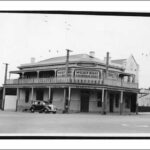

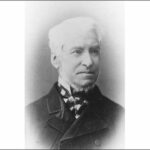
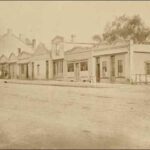
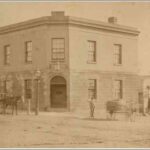

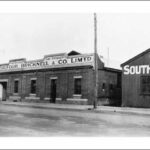
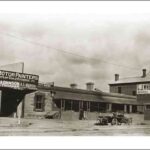
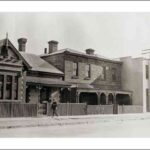
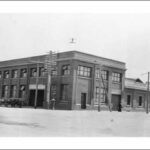
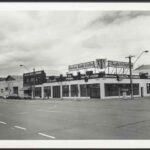

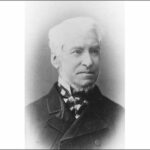
Comments